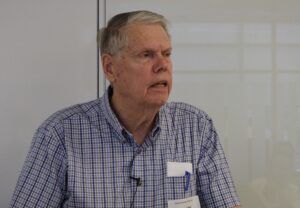From: Richard Tell Associates, Inc.
What: RF Can’t Hurt You… Can It? RF Safety Awareness
When: October 8, 2019 9:00 AM
Sponsor: Rohde Schwarz
Our October 2019 event was an all-day RF Safety Seminar featuring Richard (Ric) Tell, President of Richard Tell Associates, Inc., a consulting firm specializing in electromagnetic field exposure assessment and investigation of potential radiofrequency hazards. The event was brought to you by SBE Chapter 37 Washington DC and Chapter 46 Baltimore, with special thanks to the Washington DC Section of SMPTE for logistical support, Rohde & Schwarz for providing the meeting space, continental breakfast, lunch, and snacks, and Ric Tell for traveling to our meeting and sharing his time.
Anytime Radio Frequency (RF) exposure exceeds FCC limits, steps must be taken to ensure that individuals are not over exposed. This seminar provided an easy to understand overview of knowledge to remain safe when working in RF environments. Further, it gave an in-depth explanation of the underlying basis for RF exposure limits along with practical information on assessing potential exposure for compliance with the FCC Rules. Last but not least, Ric Tell discussed interesting and practical insights gained from his half-century career devoted to RF safety that surely helped attendees gain a respectful appreciation for what RF can and can't do to harm you.
After a continental breakfast and time to socialize, the morning session answered these questions:
- Why should I view this presentation?
- How can I be sure I will be safe?
- How can exposure to RF be a hazard?
- What are examples of RF radiating systems?
- What is a hazardous level of exposure?
- How can I avoid over-exposure?
- What does time-averaging of RF exposure mean?
- What can lead to an RF burn?
- What is some practical guidance for SBE workers when close to antennas?
After lunch, the afternoon session provided detail on the following topics:
- The underlying basis of the RF exposure limits
- Specific absorption rates (SARs), coupling of RF fields to the body and the “gain” of the human body
- The FCC RF exposure limits, safety factors, averaging times, spatial averaging, relevant units of measure
- Why the OSHA standard is not used at broadcast facilities
- Contact and induced currents have never been included in the FCC regs but the IEEE standard does
- Changes in how newly revised IEEE and ICNIRP exposure limits are to be applied (will the FCC adopt these some day?)
- RF burns - the most hazardous aspect of RF exposure
- Interference with medical devices
- Near-field gain of antennas and beam formation, not something normally talked about but relevant to safety
- Radiated fields from dish antennas, power density and size (when less can be more)
- Quantifying potential exposure using analysis and measurement
Television Technology's James O'Neal published this overview of the Seminar.
Prior to establishing his own firm, Ric served as the Chief, Electromagnetics Branch, Office of Radiation Programs, U.S. Environmental Protection Agency at Las Vegas, NV from 1967-1987. During that time, he managed a program to support development of Federal regulatory limits for exposure of the general public to electromagnetic fields and to assess environmental levels of electromagnetic fields.
Experience Highlights
- Environmental field studies of radiofrequency fields
- Radiofrequency radiation exposure standards development
- RF safety programs
- Computer modeling of antennas for RF compliance
- Automated RF/microwave measurement systems
- RF survey instrument calibrations using highly accurate electromagnetic fields
- Research on biological effects of weak, pulsed magnetic fields
- Theoretical analysis of near-field properties of antennas
- Absorption of RF energy in humans, RF contact current research
- Electric power lines and internal building wiring systems
- RF field measurements of radars, broadcast, Earth stations, dielectric sealers, etc.
- Member, IEEE TC-95 (International Commission on Electromagnetic Safety)
- Chairman, ICES Subcommittee 2 on Symbols, Terms and Hazard Communications
- Elected past member National Council on Radiation Protection and Measurements
- Member of NCRP Advisory Panel on Nonionizing Radiation
- Chairman, IEEE Committee on Man and Radiation (COMAR)
- Past participant in US-USSR scientific exchange on hazards of microwaves
Education
B.S., Midwestern University, Wichita Falls, Texas, 1966, physics and mathematics.
M.S., Rutgers University, New Brunswick, New Jersey, 1967, radiation sciences.
Additional graduate work at New York University, New York, NY, and The American University, Washington, DC.
Honors
Best paper of year award, Journal of Microwave Power (1979).
- Elevated to IEEE Life Fellow, Class of 2012.
- Recipient of 2019 Non-ionizing Radiation Distinguised Service Award from the Health Physics Society.
Personal
Born 25 January 1944, Roscoe, Texas; U.S. citizenship. Extra Class amateur radio license K5UJU
Publications
Approximately 100 reports and publications in the public domain (see list).


